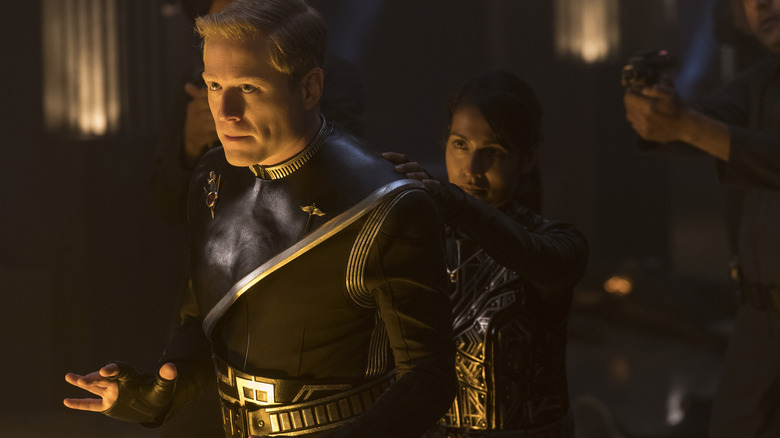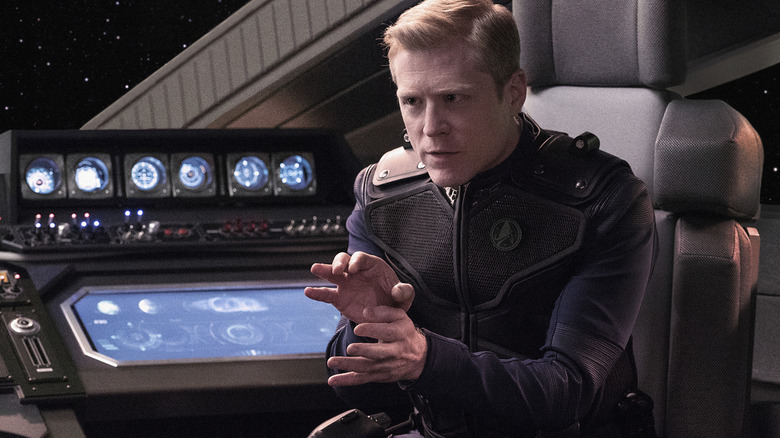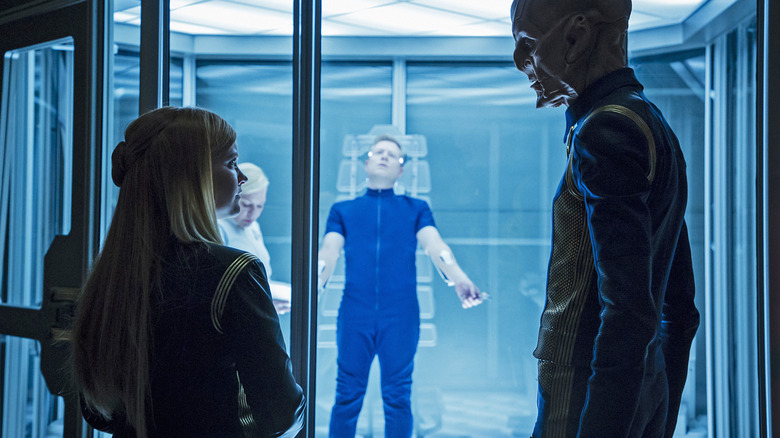How Star Trek: Discovery Brought Two Stamets Together In Season One
The first season of "Star Trek: Discovery" was swift, action-packed, and all over the place. No sooner had audiences been introduced to Michael Burnham (Sonqua Martin-Green) than a war broke out and her captain was killed. Michael was arrested for insubordination and had to travel on board the U.S.S. Discovery on her way to face a court martial. She soon found that the Discovery hosted an expert mycologist named Lieutenant Stamets (Anthony Rapp), and he had discovered a previously undetected universe-wide network of interdimensional spores. He also found that he — using tardigrade DNA — could wire the Discovery's engines into this network and teleport anywhere instantaneously. To heck with Trekking. Now we bamf about the galaxy.
To complicate matters, however, the Discovery miscalculates one of its teleportations and winds up in the notorious parallel Mirror Universe, wherein everyone is evil and Earth is an Imperial conquering force. Several "Discovery" characters, not yet well-known to the Trekkies watching, meet evil versions of themselves. We learn that Mirror Stamets was an evil poisoner for the Empire and dealt with the universe-wide mycelial network. Mirror Stamets, however, fouls up an experiment and — in the episode "What's Past is Prologue" (January 28, 2018) — projects his consciousness into the network where he meets his "good" counterpart face-to-face. They get to converse about their mutual discoveries involving the spores.
There have been numerous "Star Trek" TV show episodes about a main character meeting their doppelgängers, of course (there are too many examples to list here), but this was a first for Rapp. In a hurry, Rapp learned about the magical world of body doubles, replaying scenes, and even acting in a literal mirror. He shared his experiences with StarTrek.com back in 2018.
Inside Star Trek's mycelial network
In order to elicit two performances from Rapp, the face-to-face scene was filmed multiple times. It seems that the first take would be "good" Stamets, the second take would be "evil" Stamets and the third take would be "good" Stamets again, but this time with the actor playing opposite a stand-in now equipped with audio from the second take. This was all about timing and making a conversation natural. It was up to Rapp to stay in character while playing two characters essentially at the same time. When the real mirror was brought onto set, Rapp was officially off-balance. As he recalled:
"It was crazy because it involved a lot of intricate camerawork and we had to match the timing of each character. We recorded myself doing both sides of it, and then I had a photo double who had my voice in his ear so we could match my rhythms in playing against myself. So, it was very weird. And then, for the scene with an actual mirror, we had to do the full version as myself in the mirror because of costume changes. It was one of the craziest short-circuit brain experiences I've ever had, but it was also one of the most fun things I've ever done."
Indeed, it sounds like a fun acting challenge. Rapp now has shared an experience with all the previous "Star Trek" actors who had to act opposite their Mirror Universe counterparts, faced a transporter clone, met themselves from a slightly out-of-synch timeline, had a fistfight with a shapeshifting alien who looks like them, faced an older version of themselves from the future, met a clone, met a 50-foot clone, met a clone played by Tom Hardy, or encountered a holographic duplicate.
It happens a lot.
And now there's a third Anthony Rapp!
Rapp admitted that he had to watch the episode twice to overcome the oddness of seeing two versions of himself. Once he got over the initial shock, however, he felt the scenes played out well:
"At first, it was a little bit like, 'Mind blown.' Then, I had to watch the episodes twice to really be able to take it in. The second time I watched them, I was like, 'Okay,' and I really felt like the scenes were coming across."
Stamets continued to have an odd arc. He would eventually inject himself with tardigrade DNA and plug his own arm into the engines of the U.S.S. Discovery in order to activate its spore drive. That made him a part of the ship, a fascinating wrinkle that ultimately starts messing with his brain. Eventually, Stamets gets over it. By the time "Discovery" reached season 5, Stamets and his husband Dr. Culber (Wilson Cruz) had adopted an adult child named Adira Tal (Blu del Barrio) in order to raise them ... 950 years in the future. Unlike previous "Star Trek" shows, "Discovery" has no downtime, no bottle episodes, and no interest in establishing a "status quo." For "Discovery," the characters are always in high crisis mode, making their adventures persistently dramatic.
As of this writing, "Discovery" is wrapping up its fifth and final season. Trekkies will have to wait to see how the grand arc of the series concludes.


